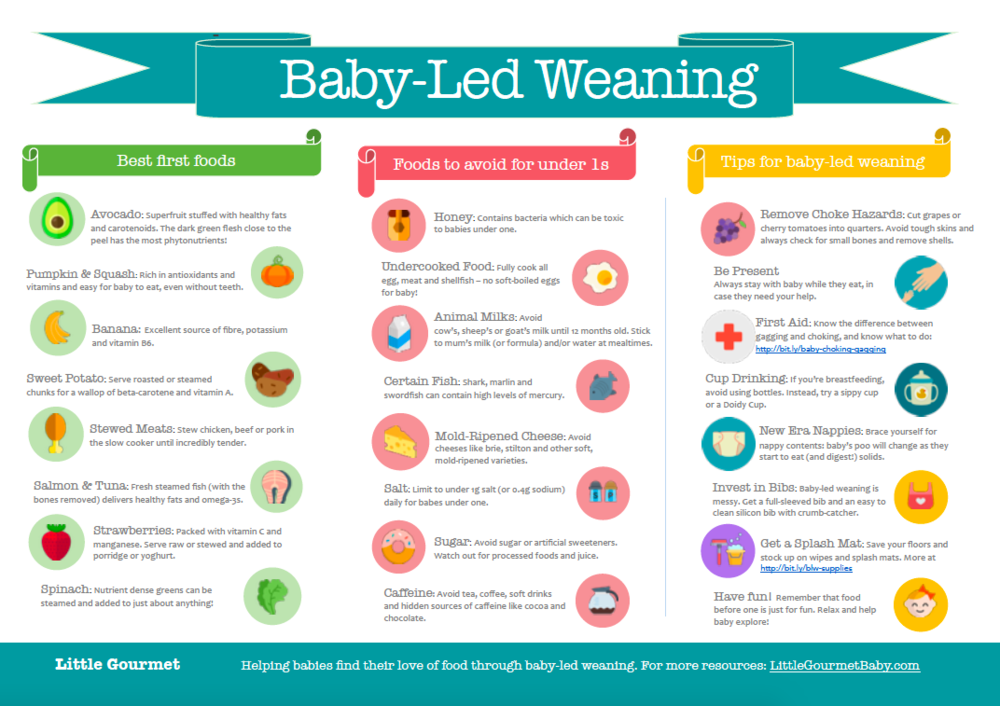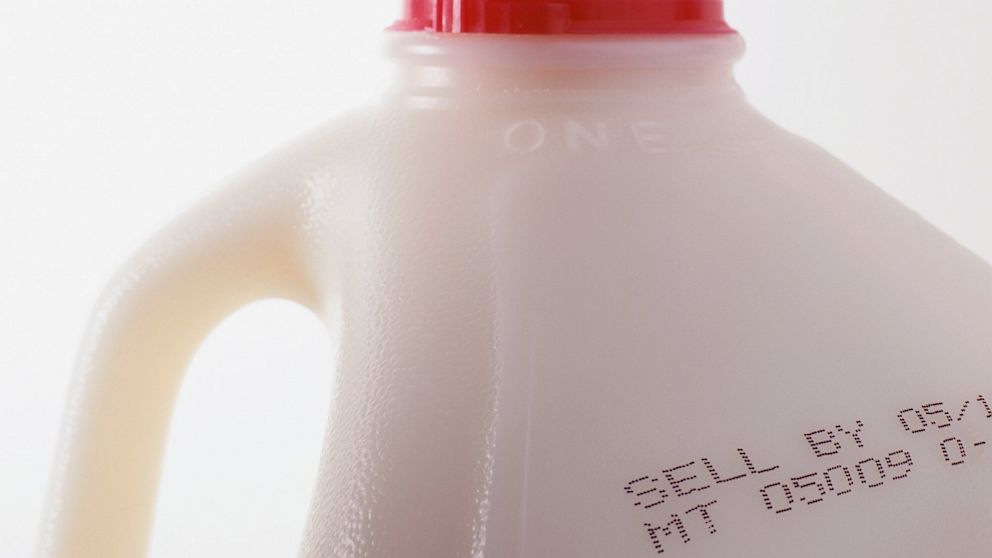What foods to start baby led weaning
Ultimate Guide to Baby Led Weaning (and Best First Foods)
Learn the basics of how to do the feeding approach known as “baby led weaning” and the best first foods for baby to make starting solids easy and fun. Plus: Learn why it’s perfectly okay to use a combined approach of blw and purees.
Baby Led Weaning
The feeding approach known as “baby led weaning” or “BLW” for short, is a style of feeding infants that allows them to feed themselves right from the start. The food is offered in thick finger-size pieces and is soft and easily squishable between your fingers. This way, the food is both easy to hold but has a low risk of choking.
TIP: This method became popular about a decade ago after the publication of the Baby Led Weaning: The Essential Guide to Introducing Solid Food by UK author Gill Rapley.
BLW Baby
One of the many reasons that people are starting to opt for this style of feeding more and more is simply that it’s easy. In many cases, you can modify foods you’re already making to share with your baby and there’s not always a lot of separate cooking involved. It also allows a baby to have control over what goes into their mouths, which sets a good precedent for letting them eat intuitively from the start.
What age should I start baby led weaning?
According to the American Academy of Pediatrics, a baby is ready to start solids with baby led weaning when:
- They’ve doubled their birth weight (at least).
- They can hold their head up well and are starting to sit up unsupported.
- They show signs of being interested in food (watching you eat, reaching for food when you’re eating, etc).
- When you feed them, they are able to move the food around in their mouths—rather than spit it right out.
TIP: Look for a highchair that allows a baby to sit up relatively straight so they can have good posture and better control over their arms and hands.
How to Start Baby Led Weaning
The first time you offer solids is such a fun milestone, so you’ll be ready once you follow these simple steps.
- Make sure baby has hit the milestones listed above to let you know that he’s ready to start.
- Get the highchair ready and adjust the straps and foot rest as needed.
- Plan to introduce water when you start solids. I recommend a trainer cup.
- Choose one food to start with and plan to offer only one food at a time.
- Stop when baby starts to fuss, turns his head away, or shows any other signs of not wanting to continue. It’s usually fairly obvious when they are done!
TIP: If you start offering solids and baby just doesn’t seem interested at all, it’s okay. Take a break for a few days or a few weeks and start again. Each kiddo has their own unique timeline.
Best Tips for Starting BLW
Here are a few more tips to consider and review before you get started.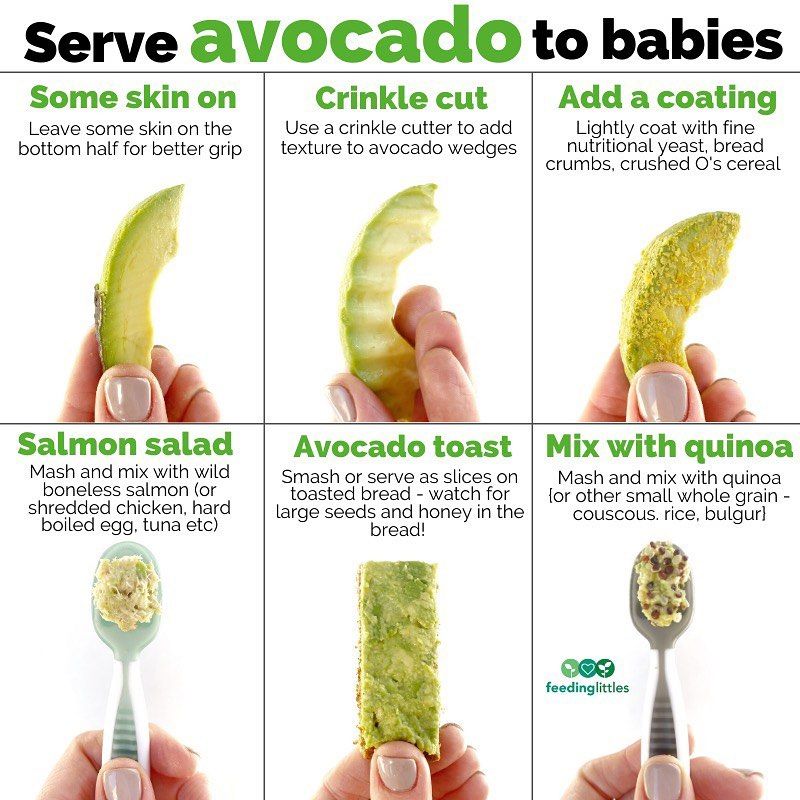
- Understand the gag reflex. Gagging is different than choking though and is most often a sign that baby is learning to move food around in their mouths—and to get it out of their mouths, which is a skill you want them to have!
- Brush up on the basics of how to know when baby is ready to start solids. (Go back to the top of this post for the signs to look for.)
- Set them up for success with a highchair that allows them to sit up straight and has foot support.
- Sit with them as you offer food.
- Check your own expectations of what will happen and simply allow your baby to take the lead.
- Start with one new food a day or every few days.
- Vary the textures of foods you offer to start exposing baby to many right from the start.
- Offer water in a sippy cup or small open cup.
TIP: Remember that breastmilk or formula will continue to satisfy baby’s hunger for the first few months of eating solids. Do not expect solids to replace milk feedings at this age.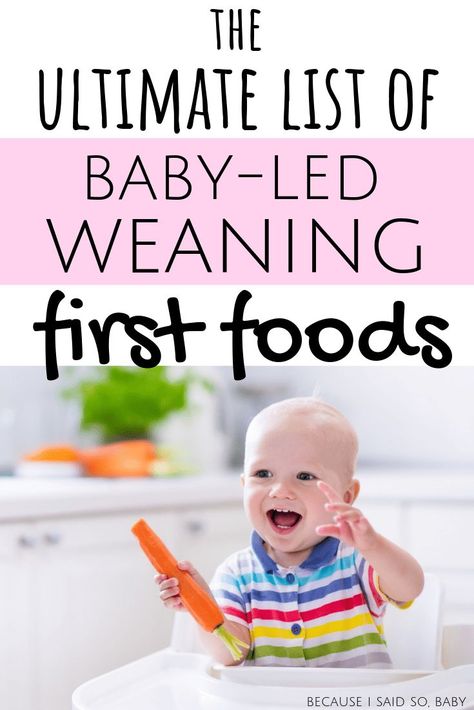
First Foods for Baby
Starting solids with baby led weaning or purees are both perfectly acceptable ways to introduce a baby to solid foods—but the topic can get so heated! There’s a lot of pressure to do it the “right” way and I’m here to say that there isn’t one. You 100% can do one or the other, or combine the two to make it work for your family. It’s all good!
Remember, the goal with first foods for baby is that they’re introduced to flavors, nutrients, and foods they can easily eat or suck on. It should be an enjoyable milestone for all involved.
TIP: It’s a good idea to get into the habit of offering an iron-rich food since iron stores in babies start to run out around 6 months and they’ll need to start ingesting it in their food.
Best First Foods for Baby Led Weaning
Here are some of our favorite first foods to offer baby led weaning style. You want foods to be finger sized so they are large enough that baby can’t force the whole piece into their mouth, and a shape that’s easy for a 6 month old to hold with their chubby little hands.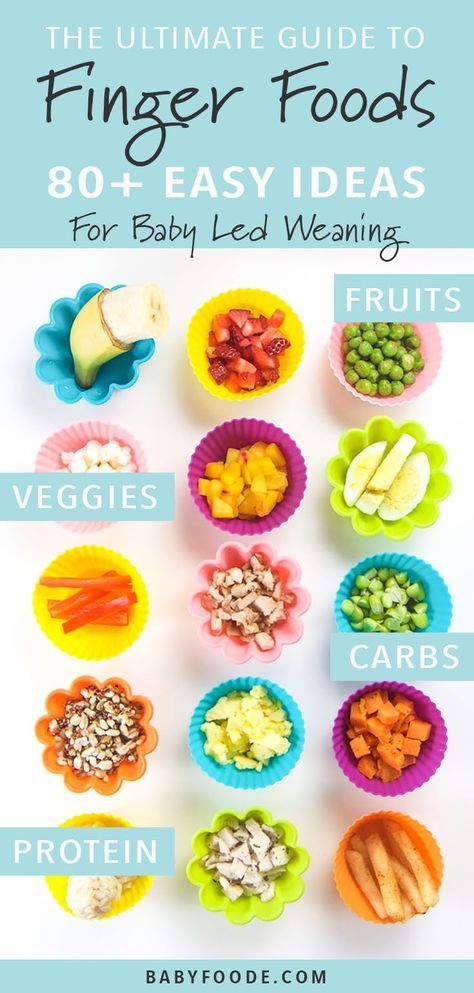 These are some of our favorites.
These are some of our favorites.
- Roasted sweet potato wedges
- Roasted apple wedges, skin on to help them hold together
- Roasted or steamed broccoli florets (big enough for baby to hold)
- Melon slices
- Thick mango slice
- Banana with some of the peel still on
- Toast sticks with mashed avocado
- Avocado spears (make sure the avocado is ripe and soft)
- Lamb or beef, on the bone or a large piece for baby to suck on
- Dark meat chicken, on the bone or a large piece for baby to suck on.
TIP: The foods should generally be soft enough to squish between your fingers with the exception of the large pieces of meat. If baby gnaws a piece down into a smaller piece, replace it with a larger one to avoid her putting a chunk of food into her mouth.
Baby Led Weaning Banana
To serve a banana to a baby, wash it well, then slice it in half. Cut off an inch or two of the peel, but leave the rest of the peel on so it’s not slippery for baby to hold.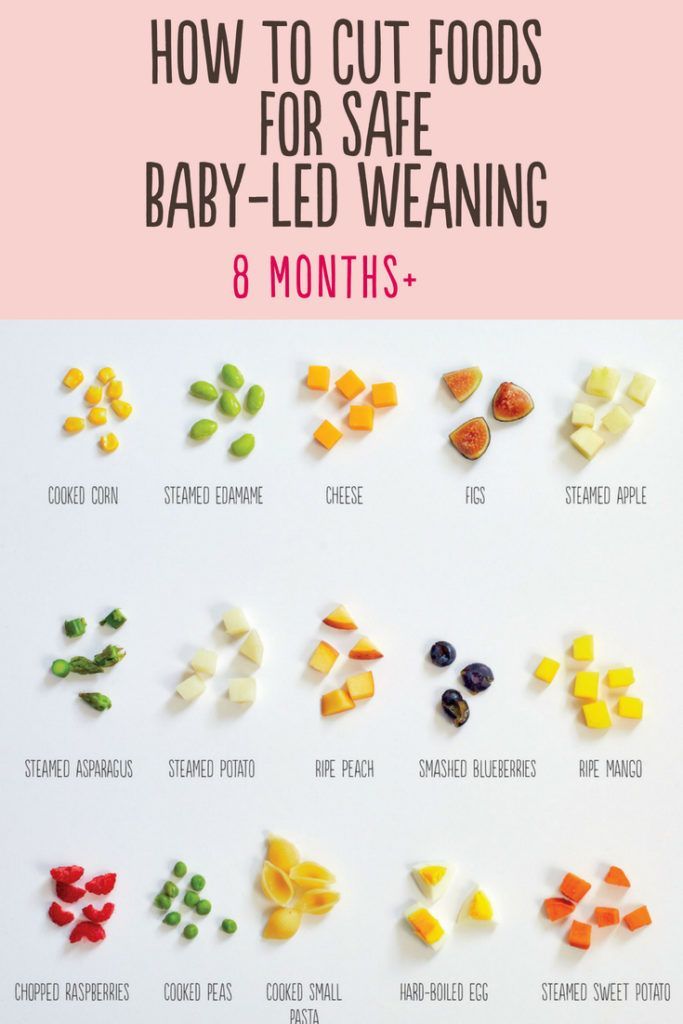 They’ll suck on the top part like a little popsicle! You can also help them hold the banana if needed.
They’ll suck on the top part like a little popsicle! You can also help them hold the banana if needed.
Foods to Avoid Serving While Doing BLW
You want any foods you offer to a baby while doing baby led weaning to be soft enough to squish between your fingers and safe for them to eat and digest. Plan to avoid:
- Anything hard, sticky, or crunchy (like raw apple or carrot, whole nuts, crackers, or a big spoonful or nut butter)
- Added salt
- Cow’s milk (which is difficult for kids under 1 to digest; plain yogurt is fine though)
- Added sugar (they simply don’t need it)
- Honey (to avoid a risk of botulism)
- Super slippery foods that would be hard for baby to hold (which can be frustrating)
TIP: Always sit with your baby and watch them try to eat. They are your best guide for making adjustments to the foods you serve.
Baby Led Weaning and Choking
There are many parents who dislike this method of feeding because it often sounds like a baby is choking.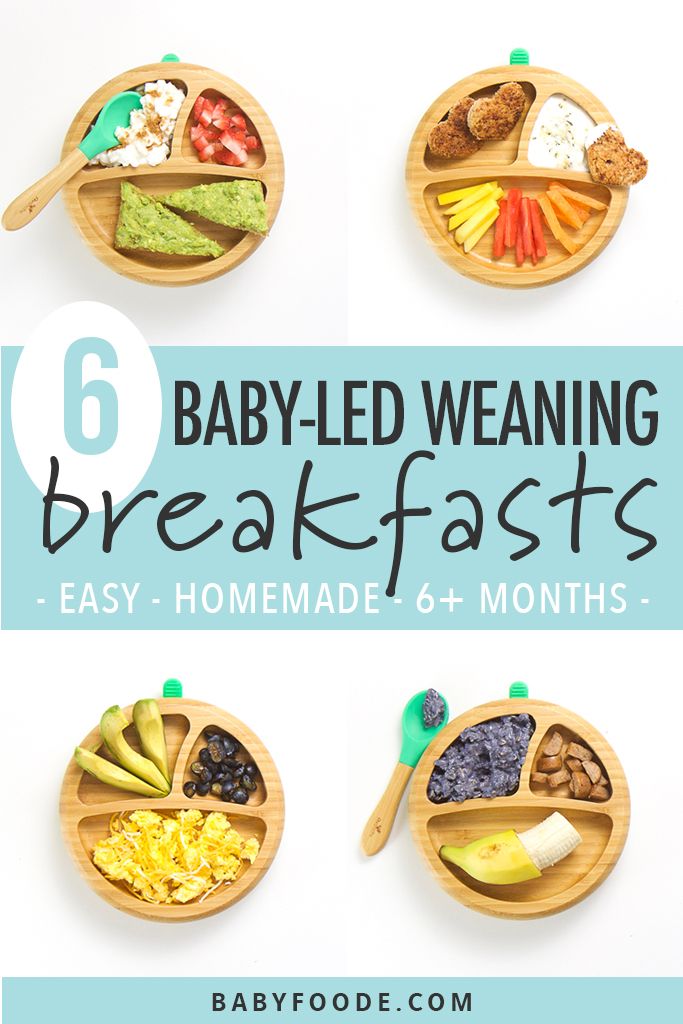 And while there are surely some incidences of choking, what’s more likely is that a baby will occasionally gag on a piece of food that gets into their mouth that they weren’t expecting.
And while there are surely some incidences of choking, what’s more likely is that a baby will occasionally gag on a piece of food that gets into their mouth that they weren’t expecting.
But remember: Gagging is a sign that baby is doing what she needs to in order to move the food around in their mouth as they learn to eat. It usually sounds more dangerous than it actually is.
TIP: If the sound of gagging really freaks you out, you’re not alone. Consider offering more preloaded spoons with purees to start your journey more slowly.
How to Cut Foods for BLW
You generally want the food to be big enough that it would be difficult for baby to put the entire thing into their mouths. Here are some specifics:
- Foods that are roughly the size of a finger, so about a 4-inch stick.
- Foods that are easy for the baby to pick up—they can’t pick up small pieces until closer to 9 months when they develop the ability to use their fingers in what’s known as a “pincer grasp”.
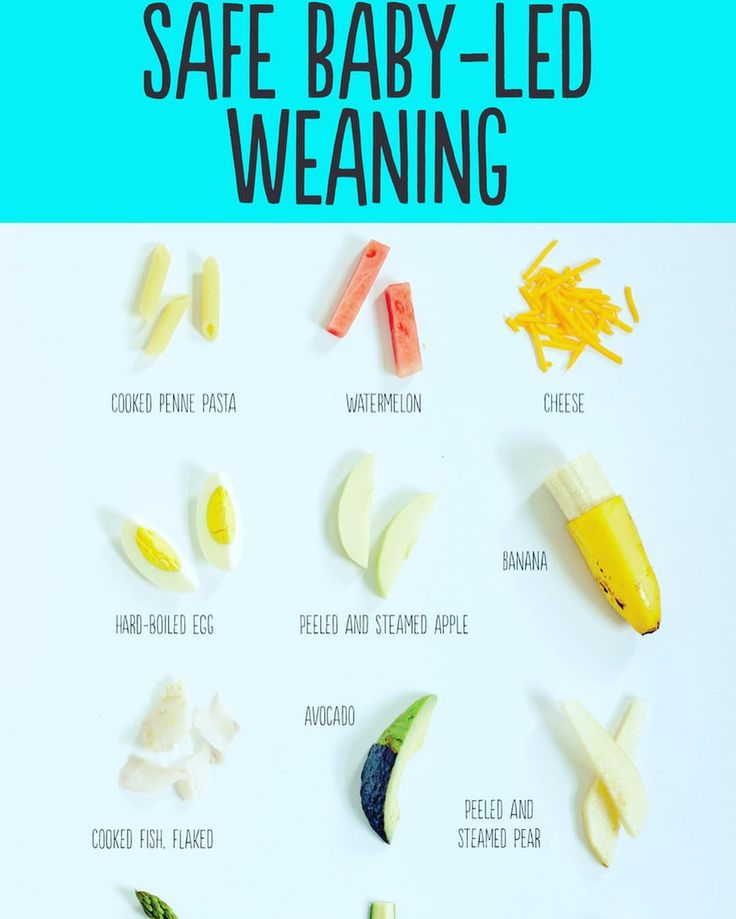
- Foods that aren’t too slippery—so you can wash and leave some of the peel on fresh foods like bananas, avocado, kiwi, and mango.
TIP: You can also go even bigger if you’re worried about size. Think half of a slice of bread or a big chunk of watermelon.
Will my baby actually eat much food with BLW?
Probably not at first. There will likely be more tasting of the food than eating of it and that is totally fine. They will still rely on breast milk or formula at this age for their main nutrition, so don’t expect them to suddenly start eating full meals. (They’ll get there in a few months, but it takes time!)
Do babies need teeth for baby led weaning?
No! Gums are super strong and front teeth aren’t used for chewing—that happens when the back molars come in. Teeth really have nothing to do with whether or not a baby can eat solids.
TIP: Learn more about what to expect from teething here.
Can you mix baby led weaning and purees?
Absolutely! I think it’s a great idea to mix the two methods simply because it gives you many more options for foods and allows the baby to experience more textures. I recommend allowing babies to feed themselves preloaded spoons—so you put the puree on a spoon, then hand it to them to actually put the spoon into their mouth—so they still have control over what goes into their mouths.
I recommend allowing babies to feed themselves preloaded spoons—so you put the puree on a spoon, then hand it to them to actually put the spoon into their mouth—so they still have control over what goes into their mouths.
TIP: Feeding some purees is also helpful if you’ll be sending food with a baby to daycare since the care provider may not have experience with blw.
Best First Foods for Baby: Purees
Here are some of our favorite purees to start offering baby when they’re ready to start solids. Remember: There’s no evidence that says that you need to start with vegetables versus fruits, so go with something that tastes good to you. Start with single foods pureed smooth and offer just a little at a time on a spoon.
- Mashed roasted sweet potato puree
- Mashed avocado puree
- Mashed banana puree
- Butternut squash puree
- Applesauce, unsweetened
- Mashed pea puree
- Oatmeal baby cereal (with added iron)
TIP: One of my favorite baby food companies is Amara Organic Baby Food, a company using a nutrient protection technology that makes organic purees just as good as homemade.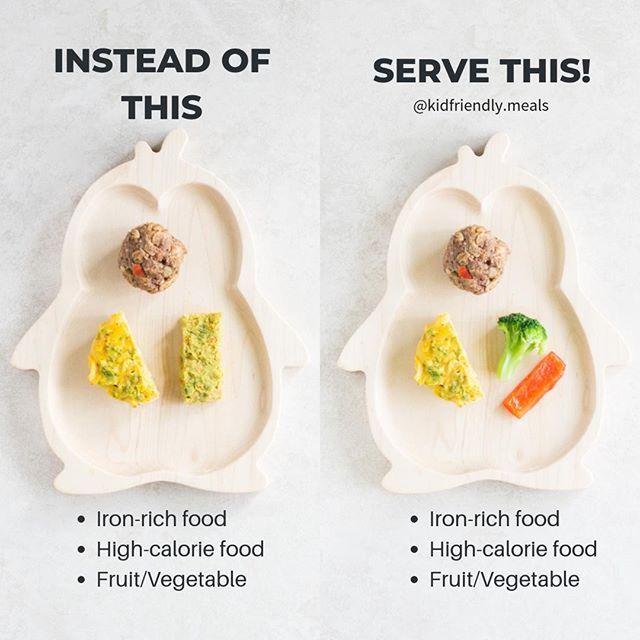 I love how easy they are to use when I need a shortcut and that they have fun baby-led weaning recipes on the side of every box! (paid affiliate link)
I love how easy they are to use when I need a shortcut and that they have fun baby-led weaning recipes on the side of every box! (paid affiliate link)
How do I know when baby has had enough?
If your baby is eating and then starts to turn her head away or just refuses to open her mouth, she’s done! Babies may also start to fuss if they’ve had enough. Learning this new skill takes time and babies can become tired fairly quickly into the process, so don’t expect them to always eat very much or to last very long at the table. This stage is about exploration!
Baby with preloaded spoon of yogurtHow to Let Baby Self Feed Purees
I love offering purees on a preloaded spoon. To do this, the parent, puts some of the food on the spoon and hands it to baby. Then baby can bring the food to their mouth all by themselves. This gives you some of the same advantages of baby led weaning, but can be more comfortable for many parents.
Remember, you can mix what you offer, going back and forth between purees and blw finger foods, so you can offer the same food two different ways to let baby explore.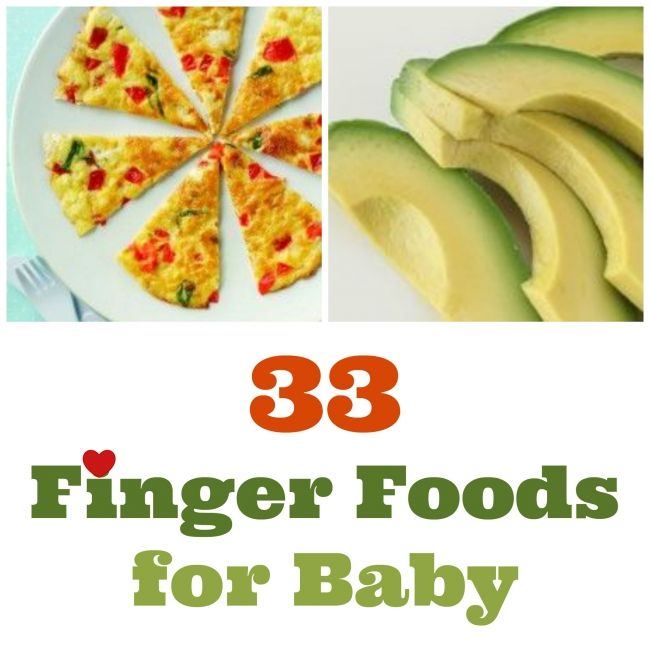 The main goal is to avoid forcing baby to take more bites than they want to, which can sometimes happen with purees.
The main goal is to avoid forcing baby to take more bites than they want to, which can sometimes happen with purees.
When to Introduce Potentially Allergenic Foods
In recent years, guidelines have been updated on when to introduce potential allergens including peanuts, eggs, and shellfish, so unless you have a family history of a food allergy, you can go ahead and introduce them soon after baby starts eating solids. In fact, research is showing that introducing these foods early can actually protect baby from developing an allergy. Talk to your pediatrician if you have concerns.
TIP: Thin unsweetened peanut butter with water to form a very thin Peanut Butter Puree until it’s about the consistency of regular yogurt and offer a very small amount on a spoon or spread on a toast stick.
What does a baby led weaning meal look like for months 7 and 8?
Until a baby is closer to 9 months and is able to pick up smaller pieces of foods, but after they have gotten the hang of one food at a time, I try to offer 1-2 foods they can feed themselves and one puree. This offers them a chance to ingest more via the puree but still feed themselves a range of textures. You can do more or less food following the lead of the child.
This offers them a chance to ingest more via the puree but still feed themselves a range of textures. You can do more or less food following the lead of the child.
TIP: My Baby Food Chart has loads of with ideas for blw foods and purees by month.
Recipes for Every Stage of Starting Solids
If you’re ready to start solids with baby, or you’re just curious what it looks like to do a mix of baby led weaning and purees, check out my Yummy Baby Food cookbook. It goes stage by stage with specific foods to start in each, with simple recipes and easy feeding tips.
Listen to a recent podcast episode to hear about some of the basics of BLW with our guest Megan McNamee, MPH, RDN, CLT, and a Registered Dietitian Nutritionist specializing in pediatric nutrition who runs Feeding Littles.
I’d love to hear any questions you have with BLW or if your baby had a first food that I didn’t list here. Please comment below to share your experience!
Prep Time 5 minutes
Total Time 5 minutes
Author Amy Palanjian
Cuisine American
Course Dinner
Calories 28kcal
Servings 1
Banana
- ▢ 1 small ripe banana with peel on
Roasted Sweet Potato
- ▢ 1 small sweet potato + 1 teaspoon olive oil
Roasted Apple
- ▢ 1 small apple + 1 teaspoon butter or neutral oil
Roasted Broccoli
- ▢ 1 cup broccoli florets + 1 teaspoon olive oil
Sauteed Green Beans
- ▢ 4 green beans 1 teaspoon olive oil
Melon
- ▢ 1 small piece watermelon or cantaloupe
Avocado Toast
- ▢ 1 slice whole grain bread
- ▢ 1 tbsp ripe avocado
Avocado Spear
- ▢ ⅛ ripe avocado
Lamb or Beef
- ▢ 1 lamb chop, roast, or steak
Pan-Seared Chicken Thighs
- ▢ 1 chicken thigh
- ▢ 1 tsp olive oil
- ▢ 1 garlic clove, optional
Banana with some of the peel still on
Cut a banana in half.
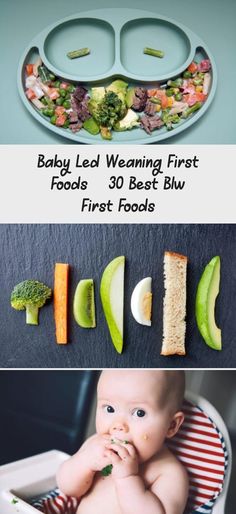 Use a knife to gently cut around the peel about 2 inches down, leaving some of the peel on so that the banana is easy for baby to hold and less slippery.
Use a knife to gently cut around the peel about 2 inches down, leaving some of the peel on so that the banana is easy for baby to hold and less slippery.
Roasted Sweet Potato Wedges
Preheat oven to 400 degrees and line a rimmed baking sheet with foil. Wash and dry the sweet potato. (You don't need to peel it.) Cut in half, then cut lengthwise into strips. Cut each strip in half again until each is about 1/2-inch thick. Slice in half horizontally if the sweet potato is very long. (Each strip should be about the size of your finger.) Place into a bowl and toss with the olive oil. Spread onto prepared baking sheet and roast for 22-25 minutes or until soft. Let cool slightly and serve.
Roasted Apple Wedges
Roasted Broccoli Florets
Preheat the oven to 400 degrees F. Place the broccoli onto a rimmed baking sheet and toss with the olive oil, coating and mixing well until all of the florets are a little shiny and coated with oil.
 Roast for 15-18 minutes or until tender. Let cool slightly and serve.
Roast for 15-18 minutes or until tender. Let cool slightly and serve.
Sauteed Green Beans
Warm the oil in a large skillet over medium heat. Add the green beans and stir. Cover and cook for about 8 minutes. Remove cover and taste one to see if it’s soft enough. Cook for an additional minute or two as needed.
Melon slices
Avocado Toast
Avocado Spears
(Make sure the avocado is ripe and soft): Cut a thick strip of avocado and offer to baby. You can leave the peel on if that makes it easier for baby to hold (just wash it first).
Lamb or Beef
Prepare a roast, steak, or chop without salt and with butter or olive oil until cooked medium well. Offer a thick slice at least the size of your finger or a drumstick.
Pan-Seared Chicken Thighs
Warm 1 tablespoon olive oil or butter in a large skillet over medium heat. Add the chicken thigh and top with a few slices of fresh garlic, if desired.
 Cover and cook for 4-5 minutes. Remove cover. Flip over and cook for an additional 4-5 minutes uncovered or until a meat thermometer registers 165 degrees F.
Cover and cook for 4-5 minutes. Remove cover. Flip over and cook for an additional 4-5 minutes uncovered or until a meat thermometer registers 165 degrees F.
- Add spices like garlic powder, cinnamon, cumin, oregano, or any other non-spicy flavor you like to make these more interesting.
- Offer just one piece at a time when starting out.
- If baby gnaws a piece down into a smaller piece, replace it with a larger one to avoid her putting a chunk of food into her mouth.
- Store any leftovers in an airtight container in the fridge for 3-5 days. Reheat briefly if needed.
- Remember that it's normal for babies to take time to actually ingest the food. Part of the process is exploring all of the senses related to the experience of eating.
Calories: 28kcal, Carbohydrates: 2g, Protein: 1g, Fat: 2g, Saturated Fat: 1g, Polyunsaturated Fat: 1g, Monounsaturated Fat: 2g, Sodium: 6mg, Potassium: 75mg, Fiber: 1g, Sugar: 1g, Vitamin A: 23IU, Vitamin C: 2mg, Calcium: 2mg, Iron: 1mg
Tried this recipe?Rate in the comments and tag @yummytoddlerfood on IG!
Printable Baby Food Chart: BLW, Purees, Finger Foods
Make feeding your baby easier with this free, downloadable baby food chart.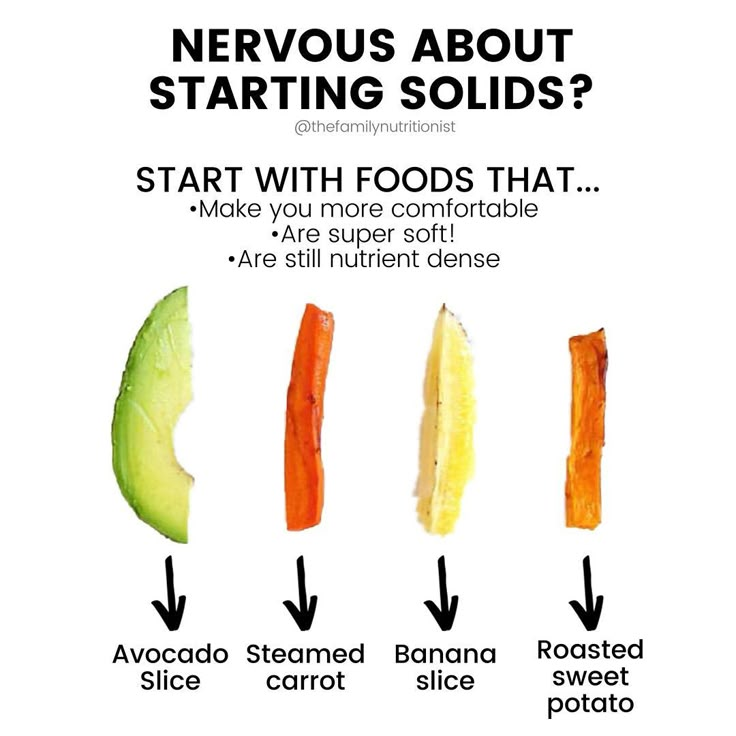 It has straight forward ideas for what to feed baby from when they start solids on up to one year—including purees, baby-led weaning style foods, finger foods, and more.
It has straight forward ideas for what to feed baby from when they start solids on up to one year—including purees, baby-led weaning style foods, finger foods, and more.
Baby Food Chart
Starting solids with a baby can be so fun and often a little challenging—but this baby food chart will help. I’ve compiled my best ideas for which foods to serve based on age and development of the baby to make it easy for you to make decisions in the kitchen.
This infant feeding chart is meant to help remind you of options you have at each age. It is not meant to add any pressure or function as a checklist of foods you have to serve (unless you want to do that!).
TIP: Download your free printable baby food chart here.
What baby foods should you start with?
Whether you start with purees or baby led weaning, starting with flavorful and nutrient-dense foods is a simple way to think about introducing foods to a baby. I love simple foods like roasted sweet potato, avocado, banana, and apple puree as first foods for a baby.
Remember that a first food is just that—a first food. It is not going to be the sole thing that determines how your child likes all foods. It can be sweet or savory, or from a variety of food groups. I would do your best to make sure that the food is easy to eat, has some flavor, and that the environment in which you offer it is free from pressure and, maybe even joyful!
What age should baby start eating foods?
The American Academy of Pediatrics recommends waiting to start solids until a baby is 6 months, and to go with wide variety of foods, introduced one at a time. But many pediatricians still say it’s okay to start rice cereal at 4 months.
If your pediatrician recommends this at the 4 month check up, ask their thoughts on the recommendation from the AAP.
TIP: Learn more about starting solids here.
How much food should I feed my baby?
The best way to know the right amount of food to give to a baby is to follow their lead. It should be very clear when a baby is done eating—they will close their mouth, turn their head, and generally make it very hard to feed them. (They may also play with their food, which is a fine way for them to interact with the foods at this early stage.)
It should be very clear when a baby is done eating—they will close their mouth, turn their head, and generally make it very hard to feed them. (They may also play with their food, which is a fine way for them to interact with the foods at this early stage.)
It’s okay if baby eats very little to start. It’s also okay if they surprise you by being very interested in food!
TIP: Download your free printable baby food chart here.
6 Month Baby Food Chart for Purees
If you’re ready to start solids with a baby, here are some foods you may want to start with. This list is perhaps more broad than you expect, but more recent research shows that it’s a good idea to introduce potential allergenic foods earlier and that lots of flavor is a great way to set baby up for eating a range of foods as they grow.
Don’t feel like you need to serve all of these foods (you 100% don’t!), but it should give you a range of ideas to consider based on season, availability, and your own preference.
- Almond butter puree
- Apple Puree
- Avocado puree
- Banana puree
- Baby oatmeal
- Bean puree
- Butternut squash puree
- Egg yolk, hard cooked mashed with water
- Green bean puree
- Melon puree
- Pea puree
- Peach puree
- Peanut Butter Puree
- Pear puree
- Pumpkin puree
- Sweet potato puree
- Whole milk plain yogurt
- Single ingredient baby food
TIP: Find more in depth details on how to know if your baby is ready to start solids here.
6 Month Baby Food Chart for Baby Led Weaning
If you decide to use the baby led weaning method of feeding, you’ll want to cut these foods into the shape of a finger or larger. The foods should also be soft and easily squishable between two fingers—like the texture of a roasted sweet potato wedge or ripe avocado.
You don’t need to feel like you have to serve all of these foods by any means, but it should give you a range of ideas.
- Apple, roasted wedge
- Avocado spears
- Banana
- Beef, ground (large piece)
- Beef hamburger patty (sliced)
- Beet, steamed or roasted
- Broccoli florets, roasted/steamed
- Cauliflower florets, roasted/steamed
- Chicken, dark meat shredded
- Cucumber
- Green bean
- Egg, hard cooked
- Egg in omelet, sliced
- Figs, halved
- Lamb
- Mango slice
- Meatball
- Melon slices
- Peach, very ripe slice
- Pear, very ripe slice
- Potato, roasted wedges
- Steak slice
- Sweet potato, roasted wedges
- Toast with mashed avocado
- Toast with mashed sweet potato
- Toast with light smear of peanut butter
- Toast with mashed hard cooked egg
- Watermelon slice
- WiId salmon
TIP: Find my Ultimate Guide to Baby Led Weaning here.
7 Month Baby Food Chart
With a 7 month old baby, you can add in a few more foods including those with more acid like citrus.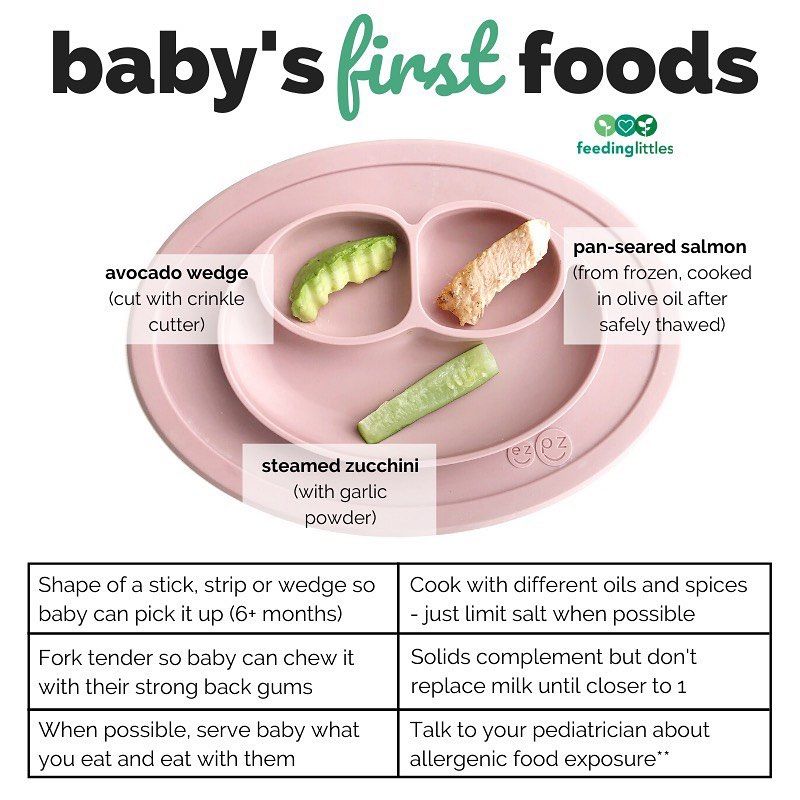 Continue serving the foods on the 6th month list, or introduce ones that you didn’t get to in that first month.
Continue serving the foods on the 6th month list, or introduce ones that you didn’t get to in that first month.
- Baby rice crackers
- Bean puree
- Beet puree
- Brussels Sprouts, pureed (or large piece for BLW)
- Guacamole
- Kiwi puree (or large piece for BLW)
- Hummus
- Mango Puree
- Mixed ingredient baby foods
- Orange segment for BLW
- Pineapple puree (or large piece for BLW)
- Prune puree
- Strawberry puree (or large strawberry for BLW)
- Spinach puree
- Smoothies (simple)
- Tomato sauce
- Tomato sauce with ground meat
TIP: Try my 10 easy No Cook Baby Foods.
9 Month Baby Food Chart
As a baby nears the 9 and 10 month mark, they will begin to be able to pick up small, pea-size pieces of foods with their fingers. This development of the “pincer grasp” means they are ready to start sampling table foods.
A good rule of thumb is to cut foods to about the size of a pea and to serve them very soft and easily squishable between your fingers.
Bread-like textures in foods like pancakes and muffins may be difficult for your child, so you may want to moisten them with water, applesauce, yogurt, breastmilk, or formula.
Remember that babies learn to eat a variety of paces, so follow the lead of your baby and avoid pressuring them to eat foods or amounts of foods that they aren’t ready for. If a baby turns their head away, closes their mouth, shakes their head, or cries, they are done with food and it’s okay to end the meal.
Continue serving foods from the previous months. And try adding:
- Banana, diced and mashed slightly as needed
- Barley, cooked until very soft
- Beans, slightly mashed
- Beef, ground
- Blueberries, diced
- Cheese, shredded
- Chex cereal
- Chia seed in smoothies, yogurt or oatmeal
- Chicken, ground
- Chicken, shredded and chopped into small pieces
- Clementines, diced (you may want to remove the slightly tough membrane)
- Cottage cheese
- Corn
- Flaxseed in smoothies, yogurt or oatmeal
- Goat cheese, soft crumbles
- Grapes, diced (never whole)
- Kefir, plain
- Meatball, diced
- Muffins, diced (moistened if needed)
- Millet
- O cereal
- Oatmeal
- Overnight oats
- Pasta
- Peas
- Potatoes, roasted or mashed
- Puffs
- Raspberries, diced
- Pancake, diced (moistened as needed with applesauce)
- Quinoa
- Rice
- Salmon, small pieces
- Tofu, diced
- Tomatoes, fresh
- Tilapia, small pieces
- Turkey, ground
TIP: Find my best Early Finger Foods, which will cover this stage and early toddlerhood.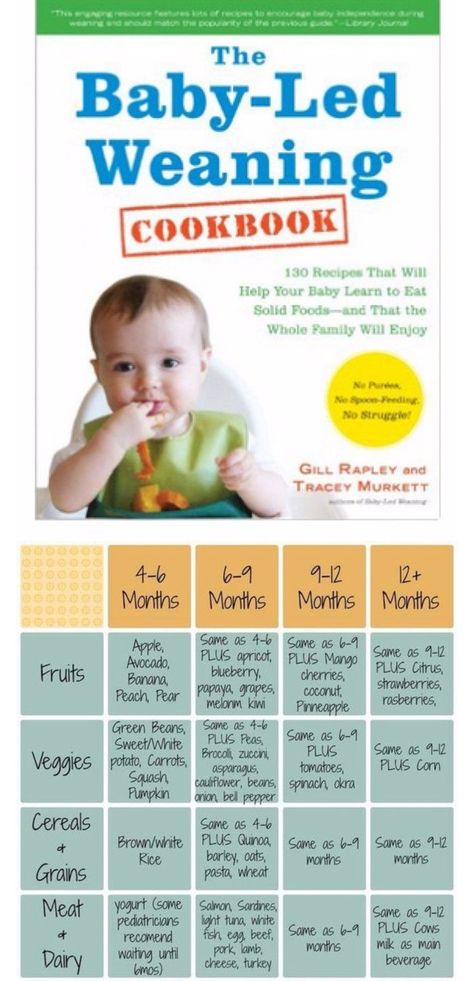
Best First Finger Foods for Baby
I put together my go-to first finger foods for babies, which may help you narrow down which foods to start with. Each of these is a nutritious whole food that’s soft and easy for baby to eat. It’s helpful that many of these foods are ones that us grownups like too, so it should make meal planning and prep for the little ones easier on you!
Printable Baby Food Chart
Grab your free copy of my downloadable Baby Food Chart with access to my entire Resource Library of Printable charts by signing up for my newsletter.
You May Also Like
- ABC Baby Muffins
- Master List of Baby Snacks
- Extra-Veggie Baby Soup
- Sweet Potato Teething Biscuits
- Master List of Baby Food Recipes
I’d love to hear your feedback on this chart, so please comment below! I always love to hear from you guys.
This post was first published Jan 2019.
Complementary feeding scheme for children under one year old
Article author: Ovchinnikova Evgeniya Vadimovna , pediatric gastroenterologist, pediatrician
The introduction of complementary foods to a baby is quite an important event.
 Finally, a child who has previously only tried mother's milk or formula will get acquainted with new tastes, the list of which will constantly expand.
Finally, a child who has previously only tried mother's milk or formula will get acquainted with new tastes, the list of which will constantly expand. Complementary foods are not only food, they are also new experiences. According to what scheme to introduce complementary foods to a child under one year old? Says pediatrician Evgenia Vadimovna Ovchinnikova.
In a newborn baby, the intestines are practically sterile, and the digestive system is in an immature state, so it can only absorb breast milk or adapted formulas. But gradually the gastrointestinal tract matures, and by 4-6 months, enzymes are already being produced that contribute to the absorption of other types of food. The optimal time for the introduction of complementary foods (in terms of both the maturity of the gastrointestinal tract and the formation of food tolerance) is the age from 4 to 6 months. Early introduction of complementary foods, as well as the introduction after 6 months, increases the risk of developing allergic diseases.
In addition to reaching a certain age and developing tolerance to the adoption of new food components, you need to pay attention to such indicators as weight (it should more than double from the moment of birth), the absence of tongue movements and the presence of food interest (the baby should become interested in other foods besides milk). Before starting to introduce new foods, you should consult with your pediatrician.
At 5 months - vegetables
You need to start introducing complementary foods gradually and carefully, the amount of the first sample is at the tip of a teaspoon. When introducing a product, carefully monitor the reaction of the child's body: are there any allergies, are there any problems with the stomach, stool, etc. The first complementary food, as a rule, is vegetable and monocomponent. It is administered during lunch, after which the baby needs to be supplemented with milk. You can start with squash or zucchini, then add cauliflower, broccoli, and lastly pumpkin and carrots.
The very first additions should be fairly thin, but the consistency should be gradually increased until the consistency of puree is obtained. For a week, if everything is fine, you can bring the amount of one product from a teaspoon on the first day to 150 grams on the seventh. Having introduced one type of vegetable in this way (for example, zucchini), next week you can introduce cauliflower in a similar way. It is advisable to take a month to get acquainted with vegetables. Bringing each product to the age norm, different types of vegetables can be mixed.
At 6 months - porridge
At 6 months, when several types of vegetables have already been introduced, you can try porridge. The first cereals of the baby should not contain milk and gluten. These products are practically not absorbed by the gastrointestinal tract and have a bad effect on its mucosa. Alternatively, you can add a little breast milk or formula to the porridge if the child is reluctant to eat porridge on the water.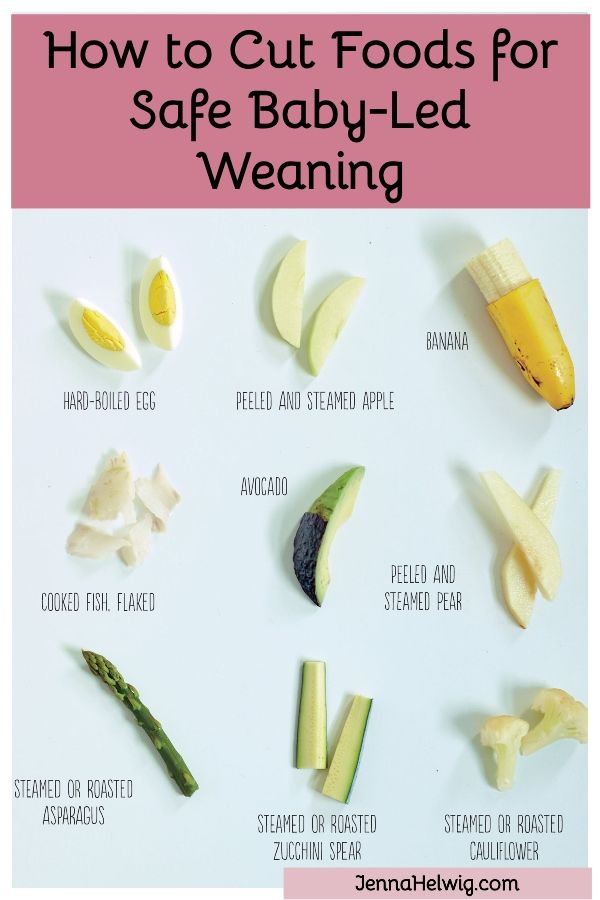 Recommended rice, corn and buckwheat porridge. The scheme for introducing cereals is exactly the same as in the case of vegetables. It is important to gradually increase the amount, and in one week to introduce only one type of cereal. It makes sense to give porridge in the second morning feeding. Closer to 8 months, in addition to cereals, you can give your child a taste of applesauce.
Recommended rice, corn and buckwheat porridge. The scheme for introducing cereals is exactly the same as in the case of vegetables. It is important to gradually increase the amount, and in one week to introduce only one type of cereal. It makes sense to give porridge in the second morning feeding. Closer to 8 months, in addition to cereals, you can give your child a taste of applesauce.
After 8 months
After 8 months you can start introducing meat puree, yolk and potatoes. It is preferable to give quail yolk, but chicken yolk is also possible if the child does not have a negative reaction. As for meat, the first product of the baby can be rabbit fillet, as the most low-fat and hypoallergenic product. After it, you can give a turkey. You need to start with 3 grams, gradually bringing up to 50 grams per day. So the child will have a breakfast consisting of porridge and fruit, and a lunch of vegetables and meat. The further diet will gradually increase: after an apple, you can introduce mashed prunes, then pear, etc.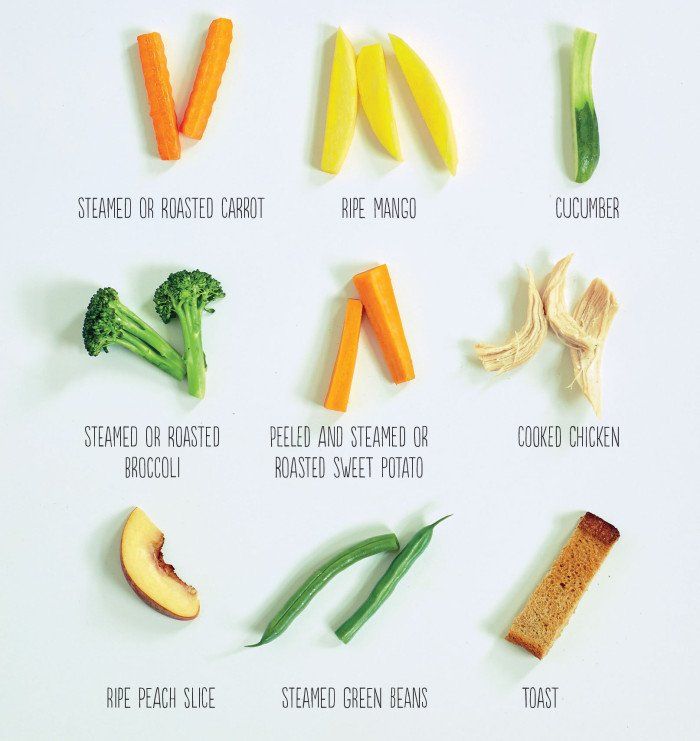 As for potatoes, its maximum amount should not exceed 50 grams per day.
As for potatoes, its maximum amount should not exceed 50 grams per day.
After 9 months
It's time to get acquainted with fermented milk products, the introduction of which has its own peculiarity: they should enter the diet especially smoothly and slowly. The first is children's cottage cheese, starting with one teaspoon, then kefir, only 5-10 ml. From these products you can eventually make an afternoon snack. Dairy products for children should not contain sugar or other additives.
After 10 months, if the child already has teeth, you can give him pieces of familiar fruit to chew on. If there are no teeth or very few, then before they appear, the food should be puree.
Important to know:
- Complementary foods for up to a year are not yet full-fledged feeding, this is only an acquaintance of the baby with different products;
- If the child does not want to eat complementary foods, do not force him, and do not add sugar or salt to the proposed product.
 You just need to postpone the introduction of this food for a week or two;
You just need to postpone the introduction of this food for a week or two; - In some cases, for example, with a small weight gain, you can start complementary foods not with vegetables, but with porridge;
- If the child has allergies, indigestion, other health problems, the product that caused the negative reaction should be discontinued;
- Complementary foods should not be introduced if the child is sick;
- For allergy sufferers, children with any diseases, the complementary feeding scheme may differ from the generally accepted one, a pediatrician's consultation is necessary;
- Do not give juices, fresh vegetables, cereals with gluten, sweet foods, cow's and goat's milk until the age of one.
Make an appointment with a pediatrician
Be sure to consult a qualified specialist in the field of childhood diseases at the Semeynaya clinic.
To find out the prices for a pediatrician's appointment or other questions, follow the link below
when and how to start the first feeding of a child?
Complementary feeding is the gradual transition of an infant from mother's milk or formula to more solid foods. Despite its naturalness, this process has some nuances. We will tell you when and where to start complementary foods so that this stage is as comfortable as possible for the baby.
Despite its naturalness, this process has some nuances. We will tell you when and where to start complementary foods so that this stage is as comfortable as possible for the baby.
Children develop in different ways: some are faster and some are slower. Therefore, at the beginning of complementary feeding of an infant, first of all, it is worth focusing not on his age, but on the presence of a number of skills. First of all, there should be food interest: the child usually “announces” this himself, starting to put his hands in his mouth, showing a desire to try food from his mother’s plate. It is also important that the baby confidently holds his head and sits, albeit with support, on the parent's lap or in a special chair. Of course, you need to make a decision about the start of complementary foods together with your doctor.
When to start complementary foods? The "golden window" is an interval of four to six months. If you believe the statistics, most often the start of complementary foods for a baby falls on the age of five to six months. We emphasize once again that everything is individual, but it is also not recommended to delay the introduction of complementary foods too much. Starting complementary foods after seven months is fraught with a delay in the development of habits for eating thicker and denser foods, and then chewing skills. In addition, late feeding can negatively affect the formation of taste sensations and lead to a lack of a number of substances in the body: iron, zinc, calcium, copper, vitamin D and others. If closer to seven months the child does not have the skills necessary to start the first complementary foods, this must be reported to the pediatrician.
We emphasize once again that everything is individual, but it is also not recommended to delay the introduction of complementary foods too much. Starting complementary foods after seven months is fraught with a delay in the development of habits for eating thicker and denser foods, and then chewing skills. In addition, late feeding can negatively affect the formation of taste sensations and lead to a lack of a number of substances in the body: iron, zinc, calcium, copper, vitamin D and others. If closer to seven months the child does not have the skills necessary to start the first complementary foods, this must be reported to the pediatrician.
Where to start complementary foods
Of course, not every food is suitable for this. You need to move on to solid food gradually, and milk porridges (especially buckwheat, rice and corn) and vegetable purees are optimal as a “link”. This is stated in the National program for optimizing the feeding of children in the first year of life in the Russian Federation, approved by the Union of Pediatricians of Russia (hereinafter referred to as the National Program) [1].
It is important to remember that the first food should be monocomponent, that is, contain only one product. Conventionally: mashed potatoes to start complementary foods can be squash or potato, but not a mix of these vegetables. By the way, babies with allergies are recommended mashed white or green vegetables. Complementary foods are better to start with microdoses, literally from a quarter of a teaspoon. Every day the volume should be increased. For convenience, you can keep a food diary and note all the dynamics in it.
The National Program recommends starting complementary foods with vegetables or cereals. Usually cereals are administered first if the child is underweight. After the baby is a little accustomed to porridge, you can add vegetables to his diet. If complementary foods begin with vegetables, the next, respectively, will be porridge. After two or three weeks, you can try giving your baby fruit puree made from apples, pears, or peaches. Later, you can add berry purees to the diet.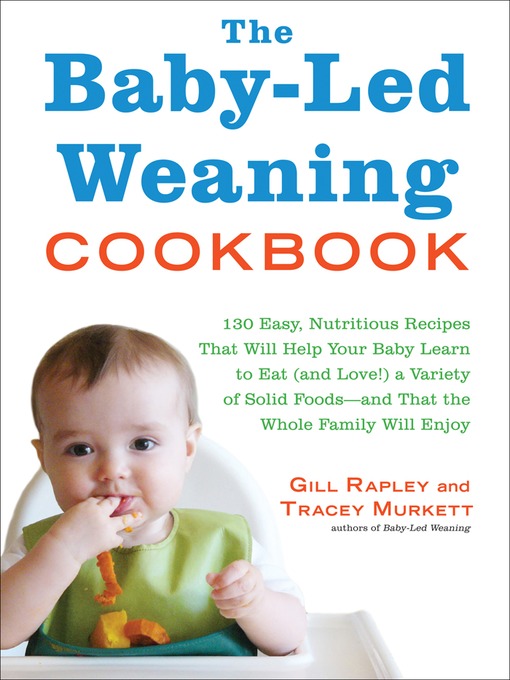
After the baby has become accustomed to mono-component complementary foods, two-component complementary foods can be introduced. For example, it can be porridge with fruit or vegetable puree. An important nuance: both components must first be “tested” separately to make sure that the child tolerates them well. You can not immediately feed the baby rice porridge with broccoli: first he needs to try rice, and the next time - broccoli. There is no need to draw hasty conclusions: for each new type of complementary foods, doctors advise taking five to ten days.
The next stage is the transition to semi-solid food. Of course, not all products are suitable here either. Cream soup, chopped pieces of boiled vegetables, meat and fish will be optimal. By the way, about meat - it should also be added carefully to the baby's diet, starting with monocomponent meat purees. At first, it is recommended to feed the baby with mashed rabbit and turkey and only then switch to beef, veal and chicken. It's the same with juices: we start with a clarified mono-fruit, apple or pear drink, and then you can expand the menu to carrot, pumpkin, plum, apricot and peach. It is worth remembering that the last three have a slight laxative effect. Closer to the year, you can try to give the child solid food - for example, small meatballs or the same cereals, only with unground cereals [2].
It's the same with juices: we start with a clarified mono-fruit, apple or pear drink, and then you can expand the menu to carrot, pumpkin, plum, apricot and peach. It is worth remembering that the last three have a slight laxative effect. Closer to the year, you can try to give the child solid food - for example, small meatballs or the same cereals, only with unground cereals [2].
An equally important product in the complementary food menu is cottage cheese. Natural curds contain calcium and phosphorus, which positively affect the functioning of the heart. In addition, the calcium contained in the cottage cheese strengthens the bones and teeth of the baby, which is very important at a “tender” age. The composition of cottage cheese also includes albumin, a protein that produces antibodies that positively affect the development of the nervous system. In addition, the use of cottage cheese helps to normalize the work of the digestive tract and liver. Experts advise introducing curd complementary foods after vegetable puree and canned meat.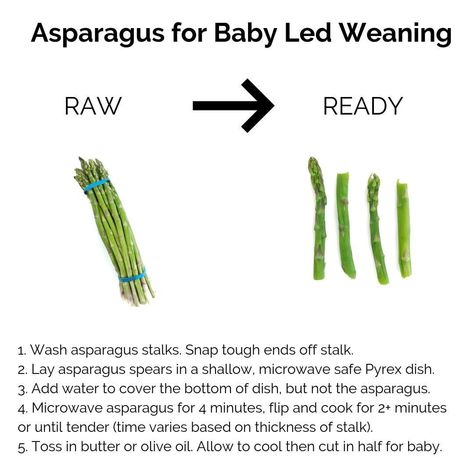 It is worth starting with a small dose - half a teaspoon - once a day. It is important to remember that cottage cheese is allowed in the diet of babies only from six to eight months. It is not recommended to give such a product before, because the protein contained in it puts a strain on the kidneys.
It is worth starting with a small dose - half a teaspoon - once a day. It is important to remember that cottage cheese is allowed in the diet of babies only from six to eight months. It is not recommended to give such a product before, because the protein contained in it puts a strain on the kidneys.
A few tips for mothers: how to introduce complementary foods without stress for the baby
If the baby does not like the product, do not refuse it categorically. It is better to remove it for four to eight weeks and then try to introduce it into the diet again, a little bit, like the first time. It is likely that the second experience will be successful: the main thing is to carefully monitor the reaction of the baby's body.
Many young mothers are also faced with a choice: cook it yourself or buy canned food? Making your own meals for your baby is usually cheaper, but it can be quite a hassle. First, you need to carefully choose the ingredients: store-bought vegetables can contain nitrates.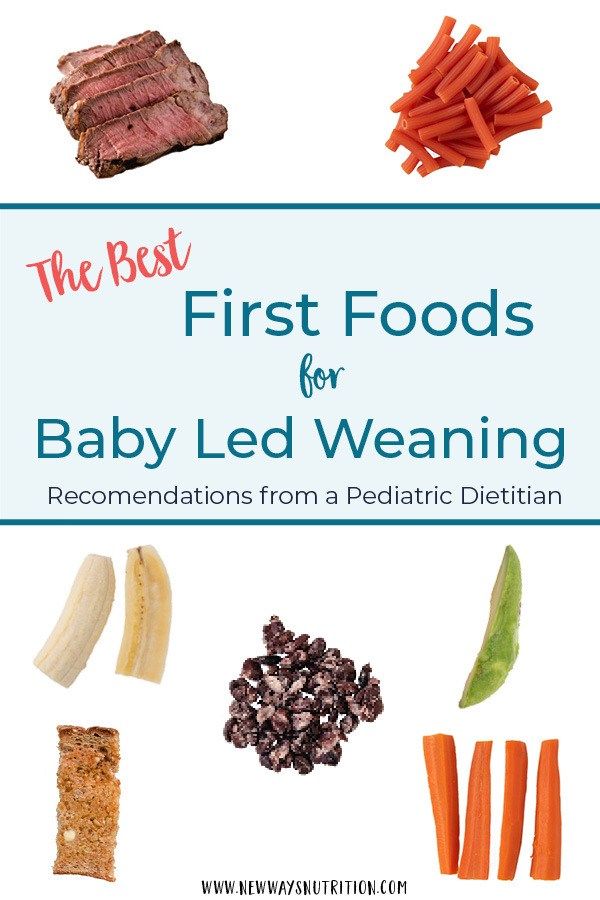 Secondly, it is better not to cook with a margin: it is difficult to maintain sterility in the home kitchen, so it is undesirable to store baby food. It is best to cook before eating so that the food is fresh. When buying mashed potatoes in the store, you should pay attention to the expiration date and compliance with storage conditions [3].
Secondly, it is better not to cook with a margin: it is difficult to maintain sterility in the home kitchen, so it is undesirable to store baby food. It is best to cook before eating so that the food is fresh. When buying mashed potatoes in the store, you should pay attention to the expiration date and compliance with storage conditions [3].
As for cereals to start feeding a child, they can be divided into dairy-free (recommended for children with lactase deficiency and allergies) and dairy. The latter, in turn, are based on an adapted milk formula, goat's or cow's milk. Compared to cow's, goat's milk is closer to human breast milk in terms of protein and fat composition.
What's more, it contains a high dose of A2 protein (β-casein), which is easy to digest and improves the intestinal microflora. But the complex protein α-s1-casein, which is found in cow's milk, is practically absent in goat's milk. That is why goat milk baby food is digested five to six times faster.